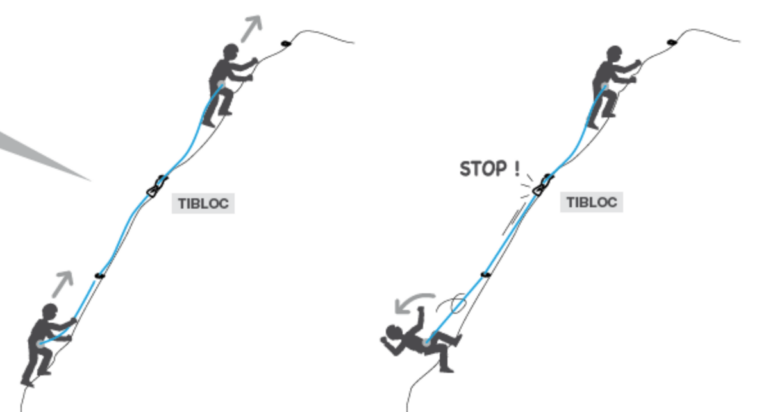Understanding Progression with a Taut Rope
Progression with a taut rope involves partners climbing simultaneously, connected by a rope under tension. While this method can save time in “easy” terrain, it comes with inherent dangers, including the potential for one climber’s fall to affect the other. The TIBLOC serves as an auxiliary tool to limit the consequences of a fall by the second climber, providing additional protection to the leader.
Installation Precautions and Safety Warnings
- Anchor Selection
- Anchors must be solid enough to hold the second’s fall and potentially both climbers in the worst-case scenario.
- Avoid using anchors like slings over horns or loosely placed nuts, as these may shift or dislodge under tension.
- Correct Setup
- Ensure the rope passes through the TIBLOC’s carabiner so it provides additional protection to the leader.
- The TIBLOC must remain unobstructed by snow, ice, or debris to ensure proper functionality.
- Beware of the Pull Effect
- When the second falls, the rope running through the TIBLOC can cause it to lift above the anchor, reducing its effectiveness and possibly dislodging certain types of protection.
- Minimize sling length to reduce unwanted TIBLOC movement during rope tension changes.
- Double Rope Limitations
- The TIBLOC can only be used on one strand of rope. When climbing with double ropes, only one strand protects the second climber. The other strand can compromise the leader’s stability or tangle with the TIBLOC, complicating progression.
Advantages of Using a TIBLOC for Taut Rope Progression
- Time Efficiency
- Saves time in sections where the leader is confident, even if the second climber encounters difficulties.
- Allows the second climber to begin climbing while the leader approaches the next belay, optimizing rope usage on long pitches.
- Additional Protection
- Adds a layer of security for the leader by catching the second’s fall, reducing the impact on the leader’s position.
- Helps protect the easier exit portion of a route when the second climber is still in a challenging section.
Disadvantages and Risks of Using a TIBLOC
- Lifted Protection
- Rope tension can lift slings or nuts from their placements, particularly when the TIBLOC moves excessively.
- This issue is exacerbated with ascenders that have springs.
- Limited Mobility
- The second climber cannot descend without assistance. If progress halts, the leader cannot manipulate the TIBLOC remotely to facilitate a descent.
- The leader’s descent is also complicated, as slack above the TIBLOC introduces a dangerous loop.
- Rope Damage
- In some cases, the rope’s sheath may sustain damage due to friction during jamming. Although Petzl tests have shown the TIBLOC reliably jams, manual engagement is not possible in this scenario, increasing the likelihood of sliding.
- Double Rope Complexity
- When using double ropes, twists, tangles, or interactions between strands can obstruct the TIBLOC’s operation, diminishing its protective capabilities.
Key Takeaways
- Expert Use Only: Progression with a taut rope is inherently risky and should be performed only by highly experienced climbers who understand the relationship between risks and advantages.
- Supplementary, Not Primary: The TIBLOC provides additional protection but does not replace proper belaying techniques or eliminate the risks of taut rope progression.
- Equipment Mastery: Climbers must be thoroughly trained in using the TIBLOC and its interaction with anchors, ropes, and carabiners.
Peace on your Days
Lance










